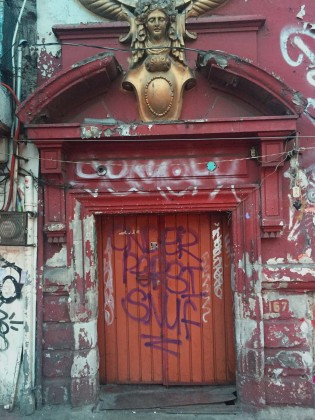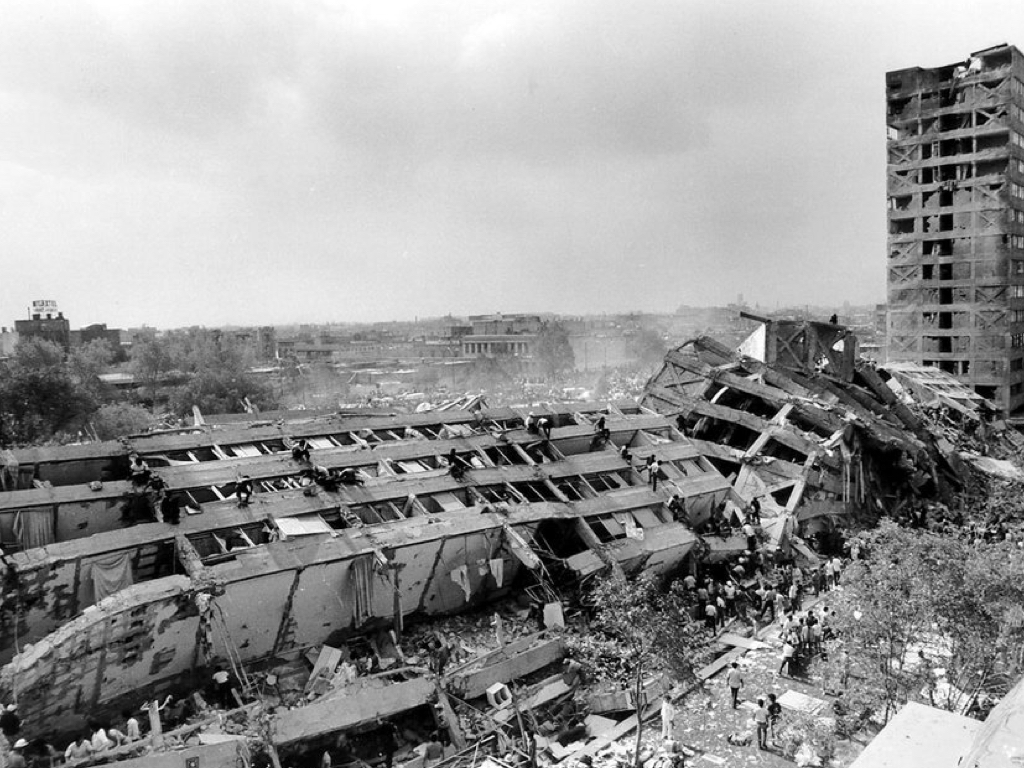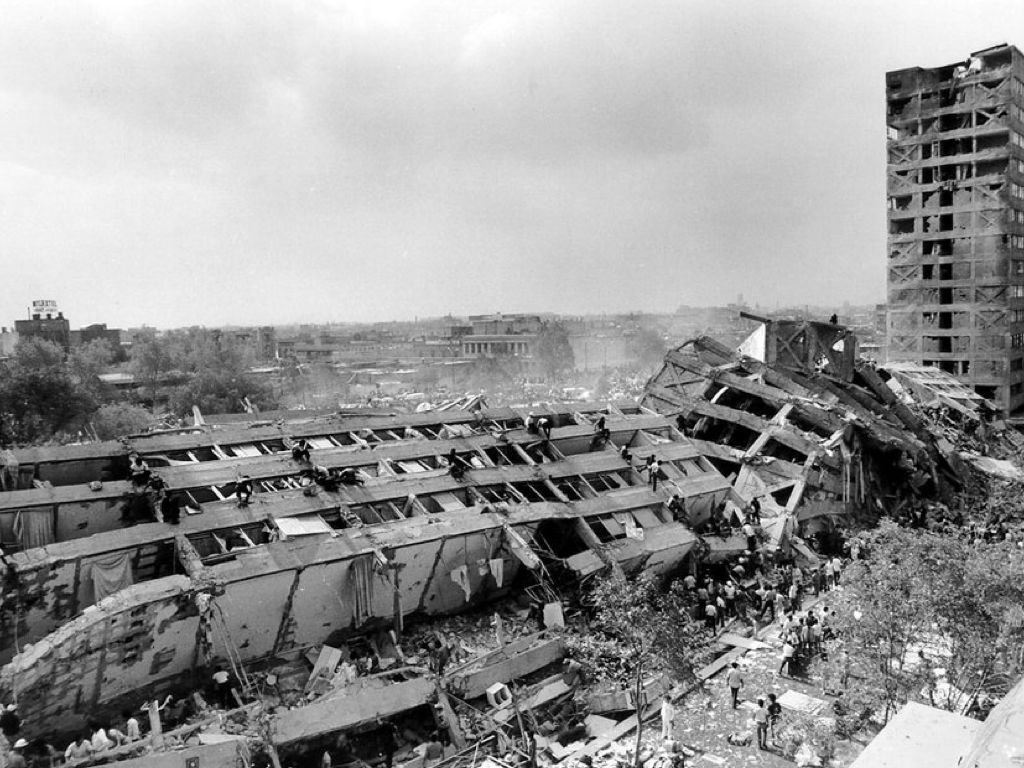The Geopolitics & Geologics of Rubble at Tlatelolco
by Eric Peterson
This project looks to understand the sociopolitical transformations attending both Mexico’s debt crisis and the massive devastation wrought by the 1985 earthquake. One site through which to examine both of these processes is Nonoalco-Tlatelolco, a massive housing complex with over one hundred buildings, built between 1960 and 1965. Tlatelolco presents as an exceptional site through which to understand the historical legacies of approaches by the Mexican state to planning especially as they were under revision beginning in 1985. The complex served as backdrop to a variety of historical events especially during and after the earthquake and controversies of the state’s role as it was challenged by both internal and external forces.
I’m interested in using Tlatelolco — which is somewhat of an obvious place — as starting place from which to make an inquiry in a number of connected issues. I’m pursuing it as a case study among a larger discussion of the legacy of state-constructed concrete buildings, both in terms of the construction techniques and materials — the shaky foundations of modernism and the modern state). In terms of the studio’s ambitions for rereading the city’s history with attention to materiality, I find it a particularly apt site to start to work from in part because its sheer size and thus ability to materially transform; to simultaneously subsidize but also make precarious (through its unstable foundations) the lives of such a large segment of the center city.
HISTORY OF THE SITE
The Nonoalco-Tlatelolco housing project was commissioned by President Adolfo López Mateo in the late 1950s, designed by architect Mario Pani, and built with financing provided by Banco Nacional Hipotecario and Urbano y de Obras Publicas.
The site is located on the former lakebed dating back to the city’s Aztec origins, taking its name from one of the original aboriginal cities, and was built along with the adjacent Plaza of Three Cultures, also designed by Pani. The project was constructed on a rail yard and the site of a massive rail workers union protest. Beyond the rail yard, clearance for the site also involved as the displacement of many low-income houses. Valentin Campa argues housing was an outcome of the protest also was an appeasement. The railroad strike was meant to remind employers that the 1917 Constitution held employers responsible for providing their workers with housing. Campa concluded that housing was one of the main reasons for repression: “capitalist resistance to this obligation makes sense: they would have to invest millions of pesos in housing for their workers and employees, capital investment that did not benefit them directly.” The new project funding from international agencies who required high design design but not budget enough to ensure the project would be subsidized, instead it would be owner occupied.
The project’s 100 plus buildings were envisioned as a city-within-a city, with mixed income housing projects (one third for low income residents and much of the rest for the middle-class) covering 1.2 million square meters, and joined by schools, hospitals, markets, businesses, a church and police stations. The complex is primarily covered with, and the overall design scheme reflects the Pani’s training at the École des Beaux-Arts (where he discovered the work of Le Corbusier) with a disposition for functionalism. Among the elements unique to Tlateloco, howerver, are that 25% of the original makeup of the units contained large, three bedroom units, much larger than many social housing projects.
The plaza was the site of the 1968 student massacre, a resounding blowback to the state’s efforts to present a unified nationalism in creating both the Plaza and housing project. In 1985, Tlateloco again occupied a central stage in the aftermath of the earthquake. XX building collapsed, leaving dozens dead, and many of the other buildings suffered extensive damage. The earthquake revealed the shoddy construction of not just building in Tlateloco, but many similar other projects constructed during the massive state construction spree in the 1950s and 1960s.
In the aftermath of the earthquake, the Plaza of Three Cultures became the staging ground of many of the thousands displaced from Nonoalco-Tlateloco and the surrounding neighborhoods, as well as the major volunteer efforts that sprang up in response, in part, to the government’s inadequate relief efforts. Tlateloco factored prominently in debates over the government response, as politicians floated a plan to demolish some twenty buildings in the project that residents protested were hardly effected by earthquake damage. Many residents, in fact, rallied to demand better recovery efforts, joining part of a incipient movement of center city citizens who some say led the broader movement for reform of the corrupt PRI-led government. Is it possible to suggest here that, as they realized that international gifts meant for damage relief would have to be used to offset the country’s massive debt, that political leaders attempted to demolish evidence of the now much maligned welfare state?
Nonoalco-Tlateloco today remains a vital part of the center city’s fabric, though home to only a fraction of the 100,000 it was once envisioned to house. Especially as the center city has been revitalized utilizing many of the land tenure reforms brought about by post-earthquake organizing, it might become — among many other conflicted legacies of the post-1968 state — something of an enclave of affordability.
MATERIAL / APPROACH
My project will look to understand Tlatelolco through a lens it is less frequently examined through: its materially and social history from its creation through to changes wrought on the project after the 1985 project.It is often described as an oasis in the city, containing collective urban living versus private housing provision, while new construction is very individualist. Many residents emphasize services as the best part of living in the project. Moreover, the site continues to provide useful if conflicting symbolic capital for the state. How does the project reflect and or complication transnational impulse towards these massive 1960s social housing projects?
At the same time it makes the lives of its residents precarious: can the state provide? Are the structures sound? One resident described to me that everytime a minor earthquake occurs, residents will run out of the buildings and are traumatized by memories of 1985.
Examining the trajectory of Nonoalco-Tlateloco might give the potential to make an argument about the longer legacies of state efforts, and push back against the breathlessness of accounts of neoliberal interventions to show the enduring if complicated role of the state. Much of the writing of government reform after the earthquake rightly focuses on the good to come out of citizen action following the corrupt and negligent responses of the PRI-controlled state. At the same time, much of the reforms can also be said to have, as Vale and Campanella argue, in the long run, benefited private landowners in downtown’s resurgence and led not to support for low income dwellers’s imagined. Part of my investigation will be to balance the legacy of welfare-model governance and the housing it created with the emergence of a property-rights driven downtown regeneration, in part to complicate the people versus state narrative.
Underneath the state versus people narrative, look at the diverse kinds of sociality that Tlatelolco produced historically, especially thinking about the networks. I am now looking for ways to use Tlatelolco as a case study for talking about the networks of construction embedded within the PRI led modern state. One intriguing start is to understand the role of ICA as a public-private actor benefiting from the corporatist state. I want to investigate how ICA cultivated expertise to be utilized by the state, and trying to connect it with the mass vulnerability of the state’s concrete buildings in the city center.
Nonoalco Tlatelolco
El Hostel de Escombros: on loving and dying in ruins
by Stathis Gerostathopoulos


